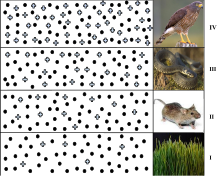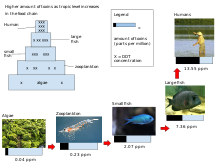

Biomagnification, also known as bioamplification or biological magnification, is the increase in concentration of a substance, e.g a pesticide, in the tissues of organisms at successively higher levels in a food chain.[1] This increase can occur as a result of:
- Persistence – where the substance cannot be broken down by environmental processes.
- Food chain energetics – where the substance's concentration increases progressively as it moves up a food chain.
- Low or non-existent rate of internal degradation or excretion of the substance – mainly due to water-insolubility.

Biological magnification often refers to the process whereby substances such as pesticides or heavy metals work their way into lakes, rivers and the ocean, and then move up the food chain in progressively greater concentrations as they are incorporated into the diet of aquatic organisms such as zooplankton, which in turn are eaten perhaps by fish, which then may be eaten by bigger fish, large birds, animals, or humans. The substances become increasingly concentrated in tissues or internal organs as they move up the chain. Bioaccumulants are substances that increase in concentration in living organisms as they take in contaminated air, water, or food because the substances are very slowly metabolized or excreted.
- ^ Silvy, Nova J., ed. (2012). The Wildlife Techniques Manual: Research. Vol. 1 (7th ed.). Baltimore, Maryland: The Johns Hopkins University Press. pp. 154–155. ISBN 978-1-4214-0159-1.